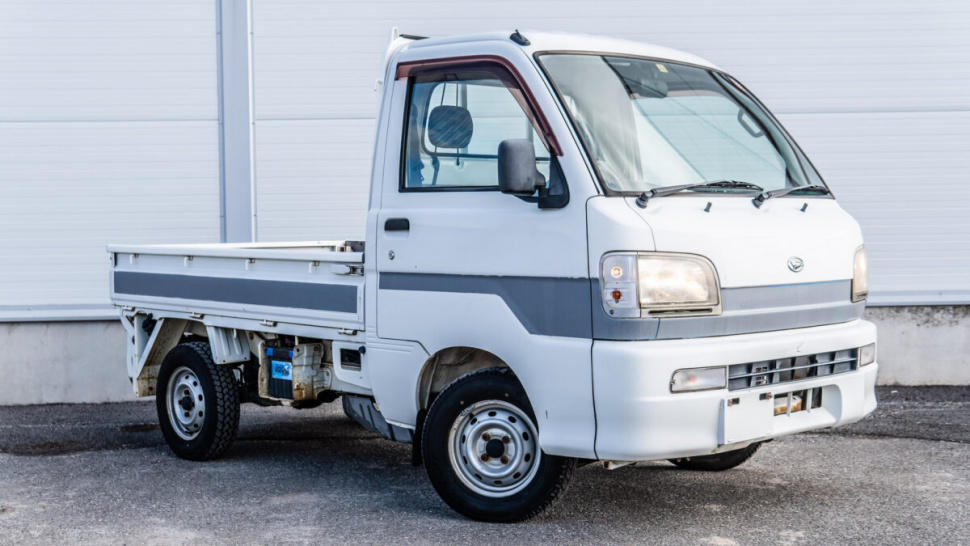As one of Japan’s most enduring kei trucks, the Hijet has become a go-to choice for entrepreneurs and small businesses across the globe. Its combination of compact size, efficiency, and durability has made it a trusted partner for tasks that require maneuverability in tight spaces, low operating costs, and dependable performance. Over the decades, this modest vehicle has gone from being a staple in Japan’s urban landscape to an international favorite, proving that small can indeed be mighty when it comes to commercial success.
The Origin of the Daihatsu Hijet in Small Business Use
First introduced in 1960, the Daihatsu Hijet was designed to align with Japan’s kei vehicle regulations, which encouraged the production of small, affordable, and fuel-efficient cars. These regulations capped engine displacement and vehicle dimensions, allowing owners to benefit from reduced taxes and insurance premiums. For small business owners, the Hijet quickly emerged as a natural solution for affordable delivery and utility transport.
Its compact footprint allowed operators to easily navigate through congested Japanese streets, making it ideal for urban businesses like bakeries, florists, and mom-and-pop shops. The Hijet was not only cost-effective but also adaptable, available in both van and truck configurations. Over time, the vehicle gained a reputation as a durable workhorse that could handle the constant demands of daily deliveries.
Why Kei Trucks Became Small Business Heroes
The success of kei trucks like the Daihatsu Hijet in delivery and small business operations comes down to a few critical factors. First, their maneuverability is unmatched. In cities with narrow streets, tight alleys, and limited parking, larger vehicles struggle to operate efficiently. Kei trucks thrive in these conditions, enabling businesses to serve customers quickly and reliably.
Second, the low cost of ownership makes them highly appealing. Not only are kei trucks affordable to purchase, but their small engines also consume less fuel, making them economical to run. For entrepreneurs working with thin margins, controlling expenses is essential, and the Hijet delivers by keeping operational costs manageable.
Third, their versatility makes them a smart investment. Businesses can configure a Hijet in multiple ways, from a refrigerated van for food delivery to a flatbed truck for construction materials. This adaptability allows one platform to serve countless industries, making it a universally valued business tool.
The Daihatsu Hijet’s Role in the Delivery Economy
Delivery services have become the lifeblood of modern economies, particularly as e-commerce and food delivery industries continue to expand. The Daihatsu Hijet has adapted seamlessly to this shift. In Japan, the vehicle remains a cornerstone of last-mile delivery, trusted by logistics companies and independent couriers alike. Its compact design allows it to reach places that larger vans cannot, speeding up delivery times and improving efficiency.
For small businesses, the Hijet provides an accessible entry point into delivery logistics without the significant financial investment required for larger vehicles. A small grocery store can use a Hijet van to deliver fresh produce to nearby neighborhoods, while a florist can transport arrangements safely through congested streets. The Hijet empowers these businesses to expand their reach and remain competitive in a fast-paced economy.
Global Expansion and Adaptation
Although kei trucks were originally developed for Japan’s domestic market, the Daihatsu Hijet has found success internationally. Exported versions of the Hijet have appeared in countries across Asia, Europe, and North America, often adapted to meet local regulations. In rural areas of the United States, used Hijet models have been repurposed for farm work and light delivery, appreciated for their compact but capable nature.
In urban centers worldwide, entrepreneurs have recognized the Hijet’s strengths. Street vendors, mobile coffee shops, and even event organizers have embraced the Hijet as a mobile business platform. Its reliability and customization options make it ideal for unique business models that thrive on flexibility. As the global demand for small-scale logistics grows, the Hijet’s influence continues to spread.
Practicality and Durability for Business Owners
At the heart of the Hijet’s popularity is its reputation for durability. Small business owners cannot afford frequent downtime, and the Hijet delivers consistent performance over long periods. Its simple mechanical design makes it relatively easy to maintain, with parts availability ensuring that repairs can be carried out efficiently.
This ease of maintenance is particularly valuable for entrepreneurs who prefer cost-effective upkeep without relying heavily on specialized mechanics. The ability to source Daihatsu Hijet parts readily means that downtime is minimized, and the vehicle can stay on the road where it belongs. For small businesses, this translates directly into reliability, customer satisfaction, and ultimately, profitability.
Environmental and Economic Benefits
Sustainability has become an increasingly important factor for businesses, and kei trucks align well with eco-conscious values. The Daihatsu Hijet’s compact engine delivers impressive fuel efficiency, reducing emissions compared to larger commercial vehicles. In many urban centers where environmental regulations are tightening, smaller, efficient vehicles are favored for delivery work.
Additionally, the economic advantages are clear. Fuel and maintenance savings allow small businesses to allocate resources elsewhere, whether that means expanding their product line, hiring more staff, or investing in customer service. By keeping operating costs low, the Hijet provides small business owners with a competitive edge.
Customization and Industry-Specific Uses
One of the strengths of the Daihatsu Hijet lies in its adaptability across industries. Its base design allows for significant customization, and aftermarket solutions have flourished to meet business needs. Refrigeration units, shelving, and secure cargo enclosures can be installed for food and beverage delivery. Flatbeds can be fitted with tool racks for construction and landscaping services. Mobile shops and pop-up businesses can use the Hijet as a rolling storefront.
The availability of Daihatsu Hijet parts supports this flexibility, enabling businesses to tailor their vehicles for specific purposes. Entrepreneurs can start with a standard Hijet and gradually adapt it as their business evolves, making it an investment that grows alongside them.
The Future of Kei Trucks in Small Business
Looking forward, kei trucks like the Daihatsu Hijet are poised to play an even larger role in delivery and small business logistics. The rise of electric and hybrid versions will likely further enhance their appeal, offering greater environmental benefits while retaining the affordability and practicality that define the kei class.
As consumer habits shift toward convenience and on-demand services, the demand for reliable delivery solutions will continue to grow. The Hijet is well-positioned to remain a cornerstone of this movement, bridging the gap between affordability, efficiency, and adaptability.
Conclusion
The Daihatsu Hijet has proven itself to be far more than just a compact vehicle. For decades, it has stood as a small business hero, enabling entrepreneurs to deliver goods, expand their services, and compete in an increasingly demanding economy. Its success is built on a foundation of efficiency, durability, and adaptability, all of which align perfectly with the needs of small businesses.
By offering low ownership costs, reliable performance, and flexible configurations, the Hijet continues to empower businesses both in Japan and around the world. With readily available Daihatsu Hijet parts and strong aftermarket support, it remains a practical choice for entrepreneurs who need dependable delivery solutions. In an era where mobility and efficiency define success, the Daihatsu Hijet remains an enduring champion of small business resilience.



Share the News